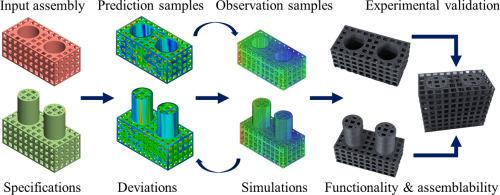当前位置:
X-MOL 学术
›
Mater. Des.
›
论文详情
Our official English website, www.x-mol.net, welcomes your
feedback! (Note: you will need to create a separate account there.)
Geometric tolerance and manufacturing assemblability estimation of metal additive manufacturing (AM) processes
Materials & Design ( IF 7.6 ) Pub Date : 2020-09-01 , DOI: 10.1016/j.matdes.2020.108842 Baltej Singh Rupal , Nabil Anwer , Marc Secanell , Ahmed Jawad Qureshi
Materials & Design ( IF 7.6 ) Pub Date : 2020-09-01 , DOI: 10.1016/j.matdes.2020.108842 Baltej Singh Rupal , Nabil Anwer , Marc Secanell , Ahmed Jawad Qureshi

|
Abstract Metal additive manufacturing (AM) has become a predominant process for manufacturing complex metal parts. However, research on controlling the geometric tolerances of the metal AM printed parts and assemblies is scarce. This paper presents a methodology to conduct a geometric tolerance and manufacturing assemblability study of the parts manufactured by metal AM. An assembly benchmark test artifact (ABTA) is designed to include mating features with given assembly conditions based on geometric tolerancing quantifiers. For virtual analysis, prediction phase ABTA samples are generated by using systematic and random field theory deviations. The prediction phase deviations are then calibrated using deviations from a numerical simulation based on a thermo-mechanical finite element model of the part. These samples or ‘skin model shapes’ are subjected to geometric tolerance and assemblability study. For experimental validation of the method, geometric tolerance quantification and actual assembly was conducted on laser powder bed fusion (LPBF) fabricated parts. The comparative analysis of the experimental and virtual results validates the new methodology and its ability to provide reliable information regarding assemblability, size dimensions and geometric tolerances. The method can be extended to any AM process for performing a virtual tolerance study and manufacturing assemblability study.
中文翻译:

金属增材制造 (AM) 工艺的几何公差和制造可组装性评估
摘要 金属增材制造 (AM) 已成为制造复杂金属零件的主要工艺。然而,关于控制金属 AM 打印零件和组件的几何公差的研究很少。本文介绍了一种对金属 AM 制造的零件进行几何公差和制造可组装性研究的方法。装配基准测试工件 (ABTA) 旨在包括具有基于几何公差量词的给定装配条件的配合特征。对于虚拟分析,预测阶段 ABTA 样本是通过使用系统和随机场论偏差生成的。然后使用来自基于零件的热机械有限元模型的数值模拟的偏差来校准预测相位偏差。这些样品或“皮肤模型形状”经过几何公差和可组装性研究。为了对该方法进行实验验证,对激光粉末床融合 (LPBF) 制造的零件进行了几何公差量化和实际组装。实验和虚拟结果的比较分析验证了新方法及其提供有关可组装性、尺寸尺寸和几何公差的可靠信息的能力。该方法可以扩展到任何用于执行虚拟公差研究和制造可组装性研究的 AM 工艺。实验和虚拟结果的比较分析验证了新方法及其提供有关可组装性、尺寸尺寸和几何公差的可靠信息的能力。该方法可以扩展到任何用于执行虚拟公差研究和制造可组装性研究的 AM 工艺。实验和虚拟结果的比较分析验证了新方法及其提供有关可组装性、尺寸尺寸和几何公差的可靠信息的能力。该方法可以扩展到任何用于执行虚拟公差研究和制造可组装性研究的 AM 工艺。
更新日期:2020-09-01
中文翻译:

金属增材制造 (AM) 工艺的几何公差和制造可组装性评估
摘要 金属增材制造 (AM) 已成为制造复杂金属零件的主要工艺。然而,关于控制金属 AM 打印零件和组件的几何公差的研究很少。本文介绍了一种对金属 AM 制造的零件进行几何公差和制造可组装性研究的方法。装配基准测试工件 (ABTA) 旨在包括具有基于几何公差量词的给定装配条件的配合特征。对于虚拟分析,预测阶段 ABTA 样本是通过使用系统和随机场论偏差生成的。然后使用来自基于零件的热机械有限元模型的数值模拟的偏差来校准预测相位偏差。这些样品或“皮肤模型形状”经过几何公差和可组装性研究。为了对该方法进行实验验证,对激光粉末床融合 (LPBF) 制造的零件进行了几何公差量化和实际组装。实验和虚拟结果的比较分析验证了新方法及其提供有关可组装性、尺寸尺寸和几何公差的可靠信息的能力。该方法可以扩展到任何用于执行虚拟公差研究和制造可组装性研究的 AM 工艺。实验和虚拟结果的比较分析验证了新方法及其提供有关可组装性、尺寸尺寸和几何公差的可靠信息的能力。该方法可以扩展到任何用于执行虚拟公差研究和制造可组装性研究的 AM 工艺。实验和虚拟结果的比较分析验证了新方法及其提供有关可组装性、尺寸尺寸和几何公差的可靠信息的能力。该方法可以扩展到任何用于执行虚拟公差研究和制造可组装性研究的 AM 工艺。











































 京公网安备 11010802027423号
京公网安备 11010802027423号